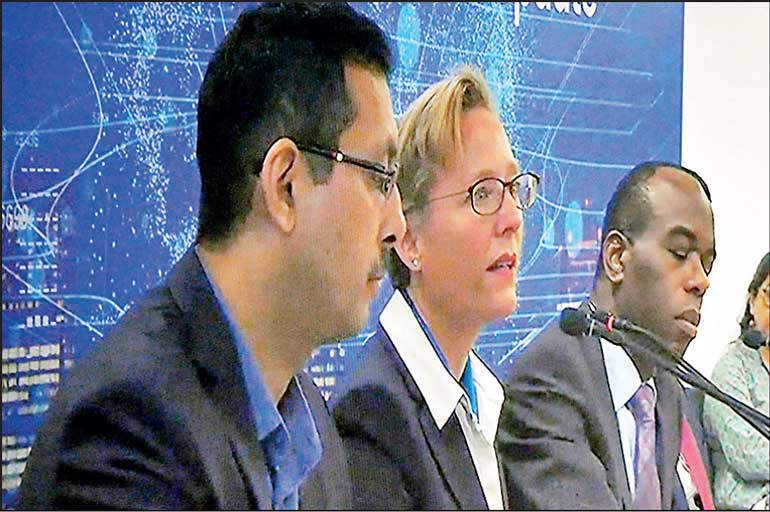Thursday Feb 27, 2025
Thursday Feb 27, 2025
Wednesday, 4 October 2023 00:05 - - {{hitsCtrl.values.hits}}

World Bank Chief Economist for South Asia Franziska Ohnsorge addresses the launch of South Asia Development Update in New Delhi
South Asia is expected to grow by 5.8% this year – higher than any other developing country region in the world, but slower than its pre-pandemic pace and not fast enough to meet its development goals, says the World Bank in its twice-a-year regional outlook.
Released yesterday, the latest South Asia Development Update, Toward Faster, Cleaner Growth forecasts growth to slow to 5.6% in 2024 and 2025, as post-pandemic rebounds fade and a combination of monetary tightening, fiscal consolidation, and reduced global demand weigh on economic activity.
Growth prospects are subject to downside risks, including due to fragile fiscal positions. Government debt in South Asian countries averaged 86% of GDP in 2022, increasing the risks of defaults, raising borrowing costs, and diverting credit away from the private sector. The region could also be affected by a further slowdown in China’s economic growth and natural disasters made more frequent and intense by climate change.
“While South Asia is making steady progress, most countries in the region are not growing fast enough to reach high-income thresholds within a generation,” said World Bank Vice President for South Asia Martin Raiser. “Countries need to urgently manage fiscal risks and focus on measures to accelerate growth, including by boosting private sector investment and seizing opportunities created by the global energy transition.”
In India, which accounts for the bulk of the region’s economy, growth is expected to remain robust at 6.3% in FY23/24. Output in Maldives is expected to grow by 6.5% in 2023 and in Nepal is expected to rebound to 3.9% in FY23/24, thanks to the strong rebound in tourism in both countries. Several countries in the region are still suffering from the aftermath of recent currency crises. In Bangladesh, growth will slow to 5.6% in FY23/24. In Pakistan, growth is forecast at only 1.7% in FY23/24, below the rate of population growth. Sri Lanka is showing signs of recovery after a severe recession and the economy is expected to grow by 1.7% in 2024, after contracting by 3.8% in 2023.
Constrained by fiscal challenges, governments have limited room to help their economies fully capitalise on the global energy transition. Though often seen as an additional burden for developing countries, for South Asia, the energy transition could present an opportunity for future growth and job creation – if it leads to more investments by firms, cuts air pollution, and reduces the reliance on fuel imports. Even with limited fiscal space, countries can encourage firms to adopt more energy-efficient technologies through market-based regulations, information campaigns, broader access to finance, and reliable power grids.
“South Asia’s energy intensity of output is about twice the global average and the region lags in the adoption of more advanced energy-efficient technologies,” said World Bank Chief Economist for South Asia Franziska Ohnsorge. “Improvements in energy efficiency, in the context of a rapid global energy transition, are an opportunity for South Asia to make progress toward both environmental and economic goals.”
The energy transition will also have significant impacts on South Asia’s labour markets. Almost one-tenth of the region’s workers are employed in pollution-intensive jobs. These jobs are concentrated among lower-skilled and informal workers who are more vulnerable to labour market shifts. While the energy transition can help create more new jobs, it could also leave some workers stranded in declining industries. The report recommends a wide range of policies to protect such workers, including providing better access to high-quality education and training, finance, and markets; facilitating worker mobility; and strengthening social safety nets.
Discover Kapruka, the leading online shopping platform in Sri Lanka, where you can conveniently send Gifts and Flowers to your loved ones for any event including Valentine ’s Day. Explore a wide range of popular Shopping Categories on Kapruka, including Toys, Groceries, Electronics, Birthday Cakes, Fruits, Chocolates, Flower Bouquets, Clothing, Watches, Lingerie, Gift Sets and Jewellery. Also if you’re interested in selling with Kapruka, Partner Central by Kapruka is the best solution to start with. Moreover, through Kapruka Global Shop, you can also enjoy the convenience of purchasing products from renowned platforms like Amazon and eBay and have them delivered to Sri Lanka.
Discover Kapruka, the leading online shopping platform in Sri Lanka, where you can conveniently send Gifts and Flowers to your loved ones for any event including Valentine ’s Day. Explore a wide range of popular Shopping Categories on Kapruka, including Toys, Groceries, Electronics, Birthday Cakes, Fruits, Chocolates, Flower Bouquets, Clothing, Watches, Lingerie, Gift Sets and Jewellery. Also if you’re interested in selling with Kapruka, Partner Central by Kapruka is the best solution to start with. Moreover, through Kapruka Global Shop, you can also enjoy the convenience of purchasing products from renowned platforms like Amazon and eBay and have them delivered to Sri Lanka.